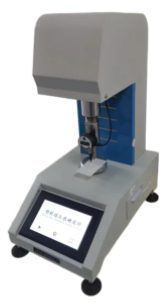ZY-QYH96 Plastic Ball Indentation Hardness Tester

1、 Overview
Plastic ball indentation hardness tester refers to the average pressure tester that a steel ball with a specified diameter is subjected to per unit of indentation area after being vertically pressed into the surface of the specimen under test load and maintained for a certain period of time. The plastic ball indentation hardness tester developed by our company adopts automatic loading, timing selection, deformation collection and other methods, and eliminates the commonly used digital block display method. Instead, it adopts touch screen color display of Chinese characters. In this way, the operator can perform experimental operations based on the Chinese character prompts on the LCD screen after turning on, greatly facilitating the user. The plastic ball indentation hardness tester is a device that measures the ability of polymer materials to resist the pressure of a rigid object that is considered to have no elastic deformation. The hardness of engineering plastics and other industry materials used in automobiles can be measured.
2、 Compliant with standards
GB3398.1-08 Plastics - Determination of hardness - Part 1: Ball indentation method
ISO2039-1-2001 Plastics - Determination of hardness - Part 1: Ball indentation method
3、 Features:
1. This instrument adopts micro processing control and integrated, digital measurement and control technology. Program according to standard testing procedures
2. Chinese color crystal display, touch screen operation, convenient and easy to understand.
3. Adopting a digital micrometer, high-precision force measurement system, high measurement and control accuracy, and stable control.
4. Micro printers perform data printing.
5. This instrument has been upgraded to touch screen control, with a novel method, convenient and convenient operation, and more user-friendly.
6. The original monochrome LCD screen has been replaced, and a large-sized 65535 true color screen has been used, resulting in better visual effects and more information displayed on the interface.
7. Improved the calculation function of experimental results, retaining decimals and rounding the results to make the calculation more accurate.
8. Various parameter settings can be set arbitrarily, making it more convenient for testers to have operational flexibility and meet more experimental requirements.
9. Any step in the experiment can be manually skipped for easy testing.
(English operation methods can be provided according to user specific requirements).
4、 Working principle:
According to the relevant requirements of the standard, the average pressure borne per unit of indentation area by a mechanism composed of a frame, a loading device, an indentation depth indicating device, a timing device, and an indenter (embedded with a steel ball with a specified diameter), when the loading device vertically presses the indenter into the surface of the specimen under a given test load and maintains it for a certain period of time. Expressed in kgf/mm2 or N/mm2.
The hardness value of ball indentation is calculated using the following formula:
0.21P
H=------------------------
25 π D (h-0.04)
In the formula: H - Ball indentation hardness, kgf/mm2 or N/mm2
P - Test load, kgf or N;
D - Steel ball diameter, mm;
H - The depth of indentation after correcting the deformation of the rack, in mm.
Note: h=h1-h2;
H1- depth of indentation under test load, mm;
H2- The deformation of the instrument frame under test load, mm
5、 Technical parameters:
1. Initial load: Ball indentation: 9.8N
2. TestingLoad: Ball indentation: 49N, 132N, 358N, 612N, 961N
3. Indentation diameter: Ball indentation: Ф 5mm, Ф 10mm
4. Sample height: 4mm
5. Minimum division value for indentation depth indication: 0.001mm
6. Timing range: 10-90S
7. Timing accuracy: ± 1%
8. Indicating accuracy: ± 2%
9. Host deformation: ≤ 0.04mm



